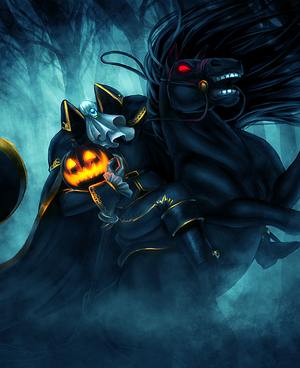No edit summary |
No edit summary |
||
| Line 1: | Line 1: | ||
[[File:The_Headless_Horseman.png|thumb|300px|The Headless Horseman]] |
[[File:The_Headless_Horseman.png|thumb|300px|The Headless Horseman]] |
||
| + | |||
The '''Headless Horseman''' appears in many stories from European folklore. In America, the image was popularized by Washington Irving's short story ''The Legend of Sleepy Hollow. ''Since then, the Horseman has appeared in many movie adaptations. The most wildly excepted image of this ghostly figure is a man dressed in black who rides atop a black horse and carries a jack-o'-lantern under his arm which serves as his primary weapon though he can also be seen carrying an axe or sword. |
The '''Headless Horseman''' appears in many stories from European folklore. In America, the image was popularized by Washington Irving's short story ''The Legend of Sleepy Hollow. ''Since then, the Horseman has appeared in many movie adaptations. The most wildly excepted image of this ghostly figure is a man dressed in black who rides atop a black horse and carries a jack-o'-lantern under his arm which serves as his primary weapon though he can also be seen carrying an axe or sword. |
||
Revision as of 21:26, 27 February 2018

The Headless Horseman
The Headless Horseman appears in many stories from European folklore. In America, the image was popularized by Washington Irving's short story The Legend of Sleepy Hollow. Since then, the Horseman has appeared in many movie adaptations. The most wildly excepted image of this ghostly figure is a man dressed in black who rides atop a black horse and carries a jack-o'-lantern under his arm which serves as his primary weapon though he can also be seen carrying an axe or sword.
History
In American Folklore
In Irving's short story, The Headless Horseman was a Hessian soldier in the American Revolutionary War who was killed in battle when a cannonball knocked off his head and has since been a spirit. He won't cross the church bridge. The story climaxes with his famous pursuit of Ichabod Crane, who disappears mysteriously from Sleepy Hollow. It is strongly implied, however, that the Horseman was Ichabod's love rival Brom Bones in disguise.
In Celtic folklore
The Irish dullahan or dulachán ("dark man") is a headless fairy, usually riding a black horse and carrying his head under one arm (or holding it high to see at great distance). He wields a whip made from a human corpse's spine. When the dullahan stops riding, a death occurs. The dullahan calls out a name, at which point the named person immediately perishes. In another version, he is the headless driver of a black carriage. A similar figure, the gan ceann ("without a head") can be frightened away by wearing a gold object or casting one in his path.
The most prominent Scottish tale of the headless horseman concerns a man named Ewen decapitated in a clan battle at Glen Cainnir on the Isle of Mull. The battle denied him any chance to be a chieftain, and both he and his horse are headless in accounts of his haunting of the area.
Sir Gawain and the Green Knight is a Middle English poem which utilizes a decapitation myth. In this medieval story, the Green Knight rides into King Arthur's court and dares any knight to behead him with his own axe. After he is beheaded, the Knight simply picks his head up, and rides back out carrying it.
In the Walt Disney film Darby O'Gill and the Little People, a headless dullahan appears driving the coisté bodhar, or Death Coach, which carries souls to the afterlife.
In German folklore
The German Legends of the Brothers Grimm (Deutsche Sagen) recount two German folk tales of a headless horseman.
One is set near Dresden in eastern Germany. In this tale, a woman from Dresden goes out early one Sunday morning to gather acorns in a forest. At a place called "Lost Waters", she hears a hunting horn. When she hears it again, she turns around she sees a headless man in a long gray coat sitting on a gray horse.
In another German tale, set in Braunschweig, a headless horseman called "the wild huntsman" blows a horn which warns hunters not to ride the next day, because they will meet with an accident.
In some German versions of the headless horseman, he seeks out the perpetrators of capital crimes. In others, he has a pack of black hounds with tongues of fire.
